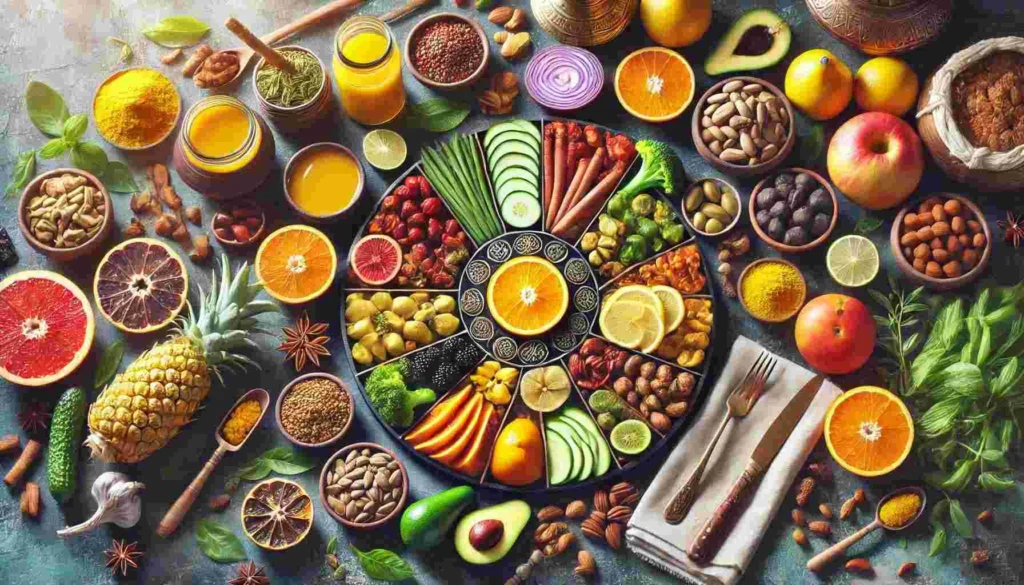
Ayurvedic Nutrition: Eating According to Your Dosha
Introduction
Ayurvedic nutrition is a holistic approach to eating that aligns your diet with your unique dosha, or body type, to promote balance and well-being. Rooted in ancient Indian traditions, Ayurveda divides individuals into three primary doshas—Vata, Pitta, and Kapha. By understanding your dosha and eating accordingly, you can improve digestion, boost energy, and support overall health. In this blog, we’ll explore the basics of Ayurvedic nutrition and how to create a diet tailored to your dosha.
What Are Doshas? Understanding the Foundation of Ayurveda
In Ayurveda, doshas are biological energies that govern the physical and mental processes of the body. Each person has a unique combination of these energies, which determines their constitution. Here’s a brief overview of the three doshas:
- Vata Dosha
- Characteristics: Light, airy, and dynamic energy.
- Governs: Movement, circulation, and breathing.
- Imbalance Symptoms: Anxiety, dry skin, and irregular digestion.
- Pitta Dosha
- Characteristics: Fiery and intense energy.
- Governs: Digestion, metabolism, and transformation.
- Imbalance Symptoms: Inflammation, heartburn, and irritability.
- Kapha Dosha
- Characteristics: Grounded, stable, and heavy energy.
- Governs: Structure, immunity, and lubrication.
- Imbalance Symptoms: Lethargy, weight gain, and congestion.
The Importance of Eating According to Your Dosha
Ayurvedic nutrition emphasizes eating foods that balance your dosha while avoiding those that aggravate it. By doing so, you can maintain equilibrium in the body and mind. This personalized approach to eating is not only about nourishing the body but also about fostering emotional and mental well-being.
Balancing Your Dosha Through Food Choices
- For Vata Dosha
- Favor: Warm, moist, and grounding foods such as soups, stews, and cooked grains.
- Avoid: Cold, raw, and dry foods like salads, crackers, and iced drinks.
- Spices: Ginger, cinnamon, and cardamom to support digestion and warmth.
- For Pitta Dosha
- Favor: Cooling, hydrating foods such as cucumbers, melons, and coconut water.
- Avoid: Spicy, sour, and acidic foods like chilies, tomatoes, and vinegar.
- Spices: Coriander, fennel, and turmeric to calm inflammation.
- For Kapha Dosha
- Favor: Light, dry, and spicy foods like roasted vegetables, legumes, and leafy greens.
- Avoid: Heavy, oily, and sweet foods like dairy, fried snacks, and sugary desserts.
- Spices: Black pepper, cumin, and mustard seeds to stimulate metabolism.
Crafting an Ayurvedic Meal Plan for Your Dosha
To effectively eat according to your dosha, it’s important to create a balanced meal plan. Here’s how you can approach this:
Vata Dosha Meal Plan
- Breakfast: Warm oatmeal with almond milk, spiced with cinnamon and nutmeg.
- Lunch: Lentil soup with steamed vegetables and basmati rice.
- Dinner: Roasted sweet potatoes with sautéed spinach and quinoa.
- Snacks: Soaked almonds or herbal teas like chamomile.
Pitta Dosha Meal Plan
- Breakfast: Fresh fruit salad with coconut yogurt.
- Lunch: Quinoa salad with cucumber, mint, and a dollop of coconut chutney.
- Dinner: Stir-fried vegetables with tofu and cooling herbs.
- Snacks: Raw carrots or a refreshing herbal tea like peppermint.
Kapha Dosha Meal Plan
- Breakfast: Warm spiced chai with no added sugar and a slice of rye toast.
- Lunch: Spicy vegetable stir-fry with millet or barley.
- Dinner: Steamed greens with grilled chicken or chickpea curry.
- Snacks: Roasted chickpeas or a piece of ginger candy.
The Role of Spices in Ayurvedic Nutrition
Spices are a cornerstone of Ayurvedic cooking. They not only enhance flavor but also bring medicinal properties to the meal. Depending on your dosha, certain spices can be especially beneficial:
- Vata: Use warming spices like ginger, cumin, and cloves to improve digestion.
- Pitta: Opt for cooling spices like coriander, fennel, and turmeric to soothe inflammation.
- Kapha: Incorporate stimulating spices like black pepper, cayenne, and mustard seeds to boost energy.
Seasonal Eating: Aligning Your Diet with Nature and Your Dosha
Ayurveda emphasizes the importance of adapting your diet to the seasons to maintain harmony with the environment. Each season influences the balance of doshas, and eating accordingly can help mitigate imbalances.
Spring (Kapha Season)
- Characteristics: Cool, heavy, and damp.
- Dominant Dosha: Kapha.
- Eating Tips:
- Focus on light, spicy, and dry foods.
- Incorporate bitter greens like kale, arugula, and spinach.
- Avoid heavy dairy and sugary foods.
- Ideal Spices: Black pepper, turmeric, and ginger to enhance metabolism.
Summer (Pitta Season)
- Characteristics: Hot, intense, and bright.
- Dominant Dosha: Pitta.
- Eating Tips:
- Emphasize cooling, hydrating foods like watermelon, cucumbers, and coconut water.
- Avoid spicy, oily, and fried foods.
- Include herbal teas like peppermint or hibiscus for a soothing effect.
- Ideal Spices: Coriander and fennel to calm excess heat.
Autumn (Vata Season)
- Characteristics: Dry, cool, and windy.
- Dominant Dosha: Vata.
- Eating Tips:
- Eat warm, moist, and grounding foods such as soups, stews, and root vegetables.
- Avoid raw and cold foods.
- Use healthy fats like ghee or olive oil to nourish the body.
- Ideal Spices: Cinnamon, cardamom, and cumin for warmth and digestion.
Winter (Kapha and Vata Season)
- Characteristics: Cold, heavy, and sluggish.
- Dominant Doshas: Kapha and Vata.
- Eating Tips:
- Focus on warming and nourishing meals like hearty stews and porridges.
- Avoid cold drinks and raw foods.
- Include energizing spices like mustard seeds and cayenne.
- Ideal Spices: Ginger, black pepper, and garlic to stimulate energy.
Ayurvedic Eating Habits: Mindful Practices for Optimal Digestion
How you eat is as important as what you eat in Ayurveda. These simple yet powerful habits can enhance digestion and absorption:
1. Eat at Regular Times
- Ayurveda recommends eating meals at consistent times to maintain the body’s internal clock.
- For example, have your largest meal at lunchtime when digestion is strongest.
2. Avoid Overeating
- Eat until you feel satisfied but not overly full. Overeating can disturb digestion and lead to imbalances.
3. Chew Your Food Thoroughly
- Digestion begins in the mouth, and chewing food properly ensures that it is easier for the stomach to process.
4. Avoid Cold Beverages During Meals
- Drinking cold water during meals can extinguish the digestive fire, known as “Agni.” Opt for warm water or herbal teas instead.
5. Eat in a Calm Environment
- Avoid distractions such as television or mobile phones while eating. This practice allows you to focus on your food and eat mindfully.
Modern-Day Tips for Integrating Ayurvedic Nutrition
Adapting Ayurvedic principles to a busy, modern lifestyle might seem challenging, but it is entirely possible with a few adjustments.
1. Meal Prepping with Ayurvedic Principles
- Prepare dosha-specific meals in advance to save time.
- Store meals in glass containers to retain freshness and avoid toxins.
2. Use Spices in Daily Cooking
- Keep a spice box with essential Ayurvedic spices such as turmeric, cumin, fennel, and ginger.
- Add these spices to soups, stir-fries, and teas to boost flavor and health benefits.
3. Carry Snacks Tailored to Your Dosha
- For Vata: Carry soaked nuts like almonds or a small thermos of warm soup.
- For Pitta: Fresh fruits like pears or a small container of coconut yogurt.
- For Kapha: Roasted chickpeas or lightly spiced vegetable sticks.
4. Hydrate Mindfully
- Drink water infused with herbs or spices to support your dosha.
- Vata: Warm water with a slice of ginger.
- Pitta: Room-temperature water with mint leaves.
- Kapha: Hot water with lemon and cayenne.
5. Prioritize Seasonal and Local Ingredients
- Shop at local farmers’ markets to incorporate fresh, seasonal produce into your meals.
- Seasonal foods naturally align with the body’s needs for that time of year.
Signs of Balance and Imbalance in Each Dosha
Recognizing the signs of dosha balance or imbalance can guide you in making dietary adjustments.
Balanced Dosha Signs
- Vata: Energetic, creative, and good digestion.
- Pitta: Sharp intellect, clear skin, and a calm demeanor.
- Kapha: Strong immunity, steady energy, and emotional stability.
Imbalanced Dosha Signs
- Vata: Restlessness, dry skin, and irregular bowel movements.
- Pitta: Anger, heartburn, and skin rashes.
- Kapha: Weight gain, sluggishness, and congestion.
The Ayurvedic Perspective on Food as Medicine
In Ayurveda, food is seen as medicine that can prevent and treat imbalances. By eating according to your dosha, you harness the healing power of food to achieve harmony in body, mind, and spirit. Whether you’re dealing with digestive issues, low energy, or mood swings, the right diet can serve as a powerful tool for self-care.
Ayurvedic Detox: Cleansing for Your Dosha
One of the cornerstones of Ayurvedic nutrition is periodic detoxification to remove accumulated toxins, known as “ama.” These toxins can disrupt the balance of doshas and lead to physical and mental discomfort. A personalized detox plan based on your dosha can help restore balance, improve digestion, and enhance overall vitality.
Vata Detox Guidelines
- Focus on Warmth: Use warm, moist foods like soups and stews to nourish and cleanse.
- Incorporate Oils: Add sesame oil to meals or practice oil pulling in the mornings to flush out toxins.
- Herbal Teas: Drink calming teas with fennel, ginger, and licorice to soothe digestion.
- Avoid: Fasting or skipping meals, which can aggravate Vata’s light and airy qualities.
Pitta Detox Guidelines
- Cool the Fire: Emphasize cooling, hydrating foods like cucumber, cilantro, and coconut water.
- Detox Drinks: Aloe vera juice or diluted lime juice can soothe inflammation and flush out toxins.
- Include Bitter Greens: Leafy greens like kale and spinach aid detoxification.
- Avoid: Spicy, acidic, or oily foods that can increase heat in the body.
Kapha Detox Guidelines
- Stimulate Metabolism: Choose light, spicy, and bitter foods to break through Kapha’s heaviness.
- Use Spices: Add cayenne, black pepper, and turmeric to meals for a cleansing effect.
- Herbal Teas: Drink hot ginger or cinnamon tea to support metabolism.
- Avoid: Dairy, sugar, and heavy grains that can worsen Kapha’s sluggish tendencies.
Combining Ayurveda with Modern Nutrition
Modern nutrition and Ayurveda may seem distinct, but they can complement each other beautifully. Many principles of Ayurveda, such as eating whole foods and maintaining balance, align with contemporary health recommendations.
Incorporating Superfoods for Your Dosha
- Vata: Add chia seeds, avocado, and sweet potatoes for grounding energy.
- Pitta: Incorporate cooling foods like blueberries, coconut, and cucumber.
- Kapha: Use metabolism-boosting options like green tea, grapefruit, and quinoa.
Probiotics and Ayurveda
- While Ayurveda emphasizes naturally fermented foods like yogurt and pickles, modern nutrition highlights probiotics for gut health. Align these principles by incorporating probiotics tailored to your dosha:
- Vata: Opt for warm, spiced yogurt with cinnamon.
- Pitta: Choose cooling options like coconut kefir.
- Kapha: Add spicy pickles or kombucha.
Mindful Eating Meets Modern Science
- Ayurveda’s emphasis on mindful eating aligns with modern research showing the benefits of slowing down during meals to improve digestion, reduce stress, and aid in weight management.
Ayurvedic Tips for Long-Term Health and Wellness
For Ayurvedic nutrition to be effective, consistency is key. Here are some simple tips to ensure long-term success while aligning with your dosha:
1. Start Small and Build Gradually
- Introduce Ayurvedic practices one at a time, such as eating warm meals or incorporating dosha-specific spices.
2. Practice Food Rotation
- Avoid eating the same foods daily to prevent imbalances. Rotating seasonal fruits, vegetables, and grains supports dosha harmony.
3. Listen to Your Body
- Ayurveda emphasizes tuning in to your body’s needs. For example, if you feel heavy and sluggish, opt for light meals, regardless of your dosha.
4. Incorporate Daily Rituals
- Ayurveda extends beyond food to daily habits. Practices like tongue scraping, oil pulling, and drinking warm water in the morning support detoxification.
5. Stay Hydrated
- Hydration is critical, but Ayurveda tailors it to your dosha:
- Vata: Warm water with a pinch of cinnamon.
- Pitta: Room-temperature water with mint.
- Kapha: Hot water with lemon and ginger.
Common Misconceptions About Ayurvedic Nutrition
Many myths surround Ayurvedic nutrition. Let’s debunk a few to clarify its principles:
1. It’s Only for Vegetarians
- While Ayurveda encourages plant-based eating, it does not exclude animal products. Dosha-specific recommendations may include dairy, eggs, or lean meats when necessary.
2. It’s Too Restrictive
- Ayurveda is flexible and focuses on balance rather than elimination. Instead of forbidding foods, it suggests moderation.
3. It’s Not Suitable for Modern Lifestyles
- Ayurvedic practices can easily be integrated into busy lives. From meal prepping to dosha-friendly snacks, Ayurveda adapts to modern needs.
Benefits of Following an Ayurvedic Diet
Adopting an Ayurvedic diet tailored to your dosha can lead to significant improvements in physical, mental, and emotional well-being.
Physical Benefits
- Improved digestion and metabolism.
- Enhanced immunity and energy levels.
- Balanced weight management.
Mental Benefits
- Reduced stress and anxiety.
- Enhanced focus and clarity.
- Stabilized emotions and mood.
Emotional and Spiritual Benefits
- Greater connection to your body’s needs.
- A sense of harmony and inner peace.
- Awareness of food as a form of self-care.



